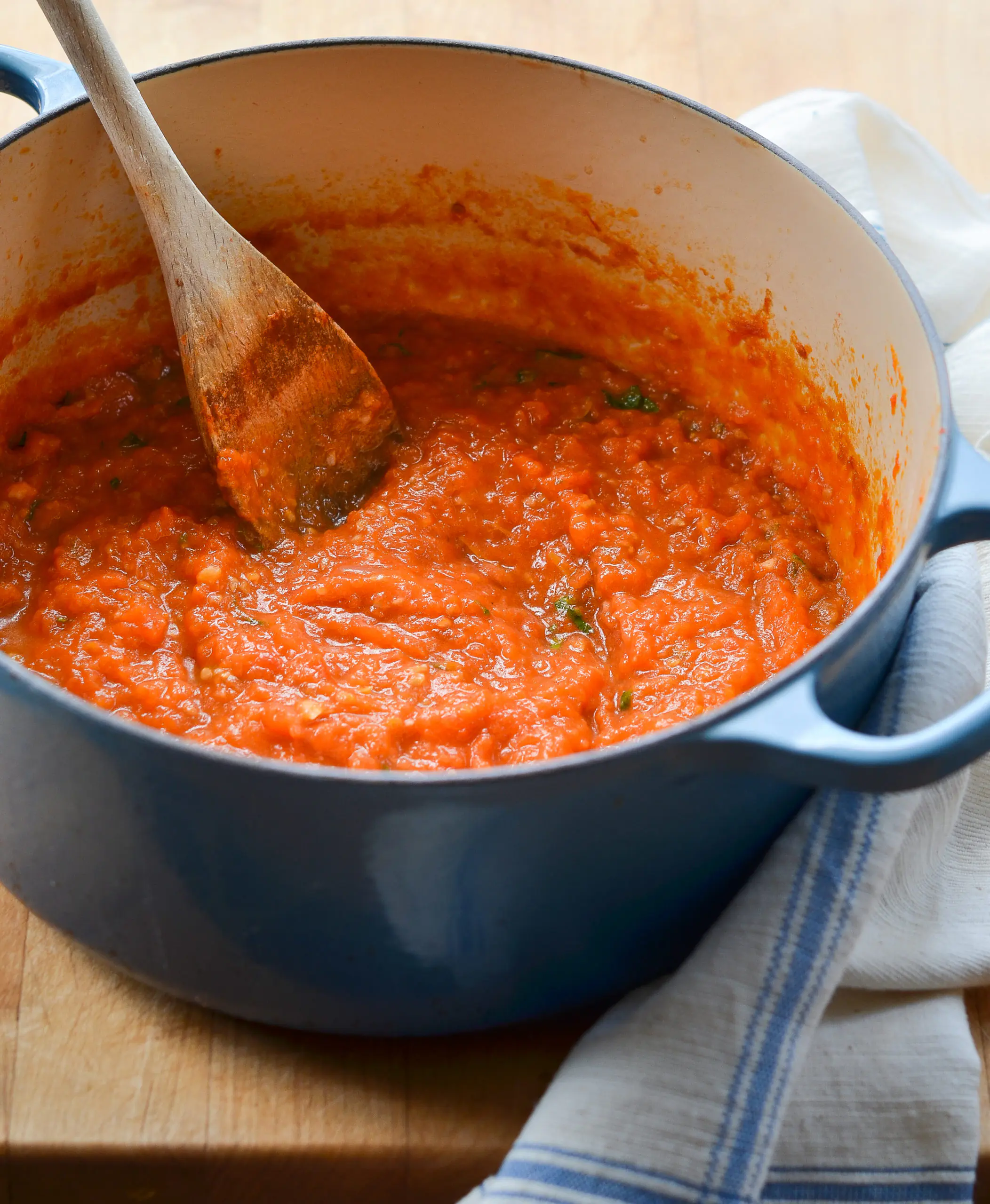To turn spaghetti sauce into pizza sauce, strain the sauce to remove excess liquid, then blend it in a food processor or blender until smooth. Add desired seasonings and salt to taste.
Using pasta sauce as a pizza sauce is a popular trend among homemade pizza lovers, as it adds variety and flavor to the pizza. Pasta sauce is usually thicker and more prosperous than pizza sauce, making it an excellent option for pizza toppings.
Following these simple steps, you can quickly transform your spaghetti sauce into a delicious pizza sauce that will elevate your homemade pizzas to the next level.

Credit: www.onceuponachef.com
Understanding The Appeal Of Using Spaghetti Sauce As Pizza Sauce
Using spaghetti sauce as pizza sauce has become a popular choice among homemade pizza enthusiasts. The thicker and richer consistency of spaghetti sauce adds a flavorful twist to pizza, offering a delicious alternative to traditional pizza sauce. It’s a great way to bring variety and creativity to your pizza creations.
Overview Of The Trend Of Using Pasta Sauce As Pizza Sauce
Using pasta sauce as pizza sauce has been gaining popularity among homemade pizza lovers. This innovative approach allows you to experiment with different flavors and create a unique taste sensation. While traditional pizza sauce has a distinct flavor, pasta sauce adds a thicker and richer element to your pizza. The versatility of pasta sauce makes it an ideal substitute for traditional pizza sauce, giving you the freedom to get creative with your toppings and elevate the overall taste of your homemade pizza.
Benefits Of Using Spaghetti Sauce For Pizza
Using spaghetti sauce for pizza offers several benefits, contributing to its growing popularity. Let’s take a look at some of these benefits:
1. Variety of flavors: Spaghetti sauce comes in various flavors, such as marinara, arrabbiata, pesto, and bolognese. Each flavor brings its unique taste to the pizza, allowing you to experiment and create customized pizzas tailored to your preferences.
2. Rich and thick consistency: Spaghetti sauce has a broader and richer character than traditional pizza sauce. This adds a lusciousness to the pizza, making every bite a delight.
3. Enhanced flavor profile: The robust flavors of the spaghetti sauce add depth and complexity to the pizza, making it more flavorful and satisfying. The combination of herbs, spices, and ingredients in the spaghetti sauce brings a burst of taste to your pizza.
4. Convenience: Using spaghetti sauce as pizza sauce is a convenient option, especially if you already have some spaghetti sauce on hand. It saves you time and effort in preparing a separate pizza sauce, allowing you to whip up a delicious pizza with minimal hassle.
Exploring The Differences Between Pasta Sauce And Pizza Sauce
While pasta sauce and pizza sauce are similar in many ways, a few key differences set them apart. These differences primarily lie in their consistency and flavor profiles.
1. Consistency: Pasta sauce is typically thicker and chunky, while pizza sauce is smoother and thinner. The thicker consistency of pasta sauce helps it stick to the pasta, while the thinner consistency allows it to spread quickly on the pizza dough.
2. Flavor: Pasta sauce is often more robust and heavily seasoned, as it needs to complement the pasta’s flavor. On the other hand, pizza sauce tends to have a milder flavor that doesn’t overpower the toppings. Pizza sauce usually contains simple ingredients like tomato paste, garlic, herbs, and olive oil.
3. Usage: Pasta sauce is made explicitly for pasta dishes and is typically cooked along with the pasta. Pizza sauce is primarily used as a base for pizzas and is often applied uncooked on the pizza dough before baking.
In conclusion, using spaghetti sauce as pizza sauce offers a delightful twist to your homemade pizzas. The thicker consistency, variety of flavors, and enhanced taste profile make it a favorite among pizza enthusiasts. So, next time you’re making pizza at home, don’t shy away from trying out your favorite spaghetti sauce as a delicious alternative to traditional pizza sauce.
Adapting Spaghetti Sauce For Pizza: Tips And Tricks
Transforming spaghetti sauce into a delectable pizza sauce is a clever way to add a delightful twist to your homemade pizzas. The thicker and richer consistency of pasta sauce makes it a perfect substitute for pizza sauce, resulting in a more flavorful pizza.
Essential Ingredients To Enhance The Flavor Of Spaghetti Sauce For Pizza
When it comes to turning spaghetti sauce into pizza sauce, there are a few essential ingredients that you can add to enhance its flavor and make it more suitable for pizza. These ingredients help create the perfect balance of flavors, giving your pizza the delicious taste you crave.
- Oregano: Oregano is a classic herb that adds a distinct Italian flavor. It pairs perfectly with tomato-based sauces and is a must-have ingredient in pizza sauce. Its aromatic and slightly peppery taste elevates the overall flavor of the sauce.
- Garlic: Whether you use fresh garlic or garlic powder, adding this ingredient to your spaghetti sauce will give it a zesty kick. Garlic adds depth and complexity to the sauce, making it even more irresistible.
- Red pepper flakes: If you prefer a little heat in your pizza sauce, red pepper flakes are the way to go. Sprinkle a pinch or two to add a subtle, spicy kick that will excite your taste buds.
- Basil: This fragrant herb is a staple in Italian cuisine. Its sweet and slightly minty flavor complements the acidity of tomatoes and adds a fresh, aromatic touch to your sauce.
- Salt and pepper: These basic seasoning elements are essential for balancing the flavors in your sauce. Taste and adjust seasoning accordingly, adding salt and pepper to taste.
How To Season And Adjust The Consistency Of Spaghetti Sauce For Pizza
When adapting spaghetti sauce for pizza, it’s important to season it properly and adjust its consistency to ensure it spreads quickly and bakes well on the pizza dough. Here are some tips:
- Seasoning: In addition to the essential ingredients mentioned above, you can also experiment with other herbs such as thyme, rosemary, or even a dash of sugar to enhance the flavor profile of your sauce. Remember to start with modest quantities and modify as needed.
- Consistency: Spaghetti sauce is generally thicker than pizza sauce. To achieve the right consistency, add a small amount of water, vegetable broth, or tomato paste to thin it out, making it easier to spread evenly on the pizza dough.
- Cooking time: Cooking your sauce for an extended period can help thicken it and intensify the flavors. Simmering the dressing melds the ingredients, resulting in a rich and more flavorful pizza sauce.
Cooking Techniques To Transform Spaghetti Sauce Into Pizza Sauce
Now that you have seasoned and adjusted the consistency of your spaghetti sauce, it’s time to transform it into a perfect pizza sauce. Here are some cooking techniques to follow:
- Blending: Depending on your preference, you can use an immersion or regular blender to puree your sauce and achieve a smoother consistency. This step helps break down any larger chunks of ingredients and ensures a more even distribution of flavors.
- Straining: Some people prefer a chunk-free pizza sauce. If that’s the case, you can push your sauce through a fine-mesh sieve to remove any solids or seeds, resulting in a smoother texture.
- Reducing: If your sauce is still too watery, simmer it over low heat to reduce the moisture content. Doing this will thicken the sauce and concentrate the flavors, giving you a more robust pizza sauce.
Following these tips and tricks, you can quickly adapt spaghetti sauce into a flavorful sauce for homemade pizza. Enjoy the process of experimenting with different ingredients and techniques to find your perfect combination!
How To Use Spaghetti Sauce As Pizza Sauce
Using spaghetti sauce as pizza sauce is a popular trend among homemade pizza lovers. It adds variety and flavor to your pizza since spaghetti sauce is often thicker and more prosperous than traditional pizza sauce. Spread the spaghetti sauce over the pizza dough and enjoy a delicious twist on traditional pizza.
Step-by-step Instructions For Incorporating Spaghetti Sauce On Pizza Dough
When it comes to using spaghetti sauce as pizza sauce, it’s essential to follow a few simple steps to ensure a delicious result. Here’s how:
- Start by preheating your oven to the recommended temperature for baking pizza.
- Roll out your pizza dough onto a baking sheet or pizza stone.
- Evenly spread a generous layer of spaghetti sauce onto the dough, leaving a small border around the edges for the crust.
- Next, add your desired pizza toppings like cheese, vegetables, meats, and seasonings.
- Place the pizza in the preheated oven and bake according to the dough’s instructions or until the crust is golden and the cheese is melted and bubbly.
- Once baked, remove the pizza from the oven and allow it to cool slightly before slicing and serving.
Creative Ways To Customize Spaghetti Sauce For Various Pizza Toppings
One of the great things about using spaghetti sauce as pizza sauce is its versatility. You can easily customize it to suit various pizza toppings and flavor profiles. Here are some creative ideas:
- Stir in fresh herbs like basil, oregano, or thyme to give the sauce more flavor.
- Sauté diced garlic and onions to add a savory depth to the sauce.
- Mix in crushed red pepper flakes or a dash of hot sauce for a spicy kick.
- If you prefer a sweeter sauce, stir in a teaspoon of sugar or honey.
- Experiment with cheese combinations to complement the sauce, such as mozzarella, cheddar, or feta.
- Add unique toppings like grilled chicken, roasted vegetables, or pineapple for a tropical twist.
Baking Tips For Achieving A Delicious Pizza Using Spaghetti Sauce
To ensure that your pizza turns out delicious and flavorful when using spaghetti sauce, here are some baking tips to keep in mind:
- Use either a pizza stone or a baking sheet covered with parchment paper to prevent the dough from sticking while baking.
- Preheat your oven adequately to ensure that the crust browns evenly and becomes crispy.
- Avoid overloading the pizza with sauce and toppings, leading to a soggy crust. Less is often more when it comes to homemade pizza.
- Olive oil or garlic butter brushed on the crust before baking adds flavor.
- Halfway through baking, rotate the pizza for even cooking.
- Let the pizza cool for a few minutes before slicing to allow the cheese to set and prevent the toppings from sliding off.
Alternatives To Traditional Pizza Sauce
Are you looking for alternatives to traditional pizza sauce? Consider turning spaghetti sauce into a flavorful pizza sauce. It’s a popular trend among homemade pizza lovers, adding variety and richness to your pizza. Simmer the tomato sauce with oregano and Italian seasoning to enhance the flavors.
Exploring Other Types Of Sauces That Can Be Used For Pizza
If you’re looking to switch up your pizza game, plenty of alternatives to traditional pizza sauce can add a unique twist to your homemade pie. By exploring different spices, you can create a whole new flavor profile for your pizza to impress your family and friends. Let’s look at some unconventional options that can turn your spaghetti sauce into a delicious pizza sauce creation.
Comparing The Flavor Profiles Of Different Sauce Options
When choosing an alternative sauce for your pizza, it’s essential to consider the flavor profile each option brings to the table. By understanding the distinct characteristics of each spice, you can make an informed decision about which one will complement your toppings and crust the best. Here are a few popular alternatives to traditional pizza sauce and their flavor profiles:
| Sauce | Flavor Profile |
|---|---|
| Marinara Sauce | A tangy and slightly sweet sauce with hints of garlic and basil. |
| BBQ Sauce | A smoky and slightly sweet sauce with a hint of spiciness. |
| Pesto Sauce | A fresh and herbaceous sauce with notes of basil and pine nuts. |
| Alfredo Sauce | A creamy and savory sauce with flavors of garlic and Parmesan cheese. |
Tips For Choosing The Best Alternative Sauce For Your Pizza
When choosing an alternative sauce for your pizza, you must consider critical factors to create the perfect flavor combination. Here are some tips for selecting the best alternative sauce for your pizza:
- Consider the toppings: Different sauces pair well with different toppings, so think about what ingredients you’ll be using and choose a sauce that will complement them.
- Experiment with flavors: Be bold, get creative, and mix and match sauces to create unique flavor combinations. For example, combining marinara sauce with pesto can add a delicious twist to your pizza.
- Balance the flavors: If your chosen sauce is rich and flavorful, consider using less to avoid overpowering the other ingredients.
- Test it out: Before slathering your pizza dough with the alternative sauce, try a small amount on a piece of bread or a cracker to see if you enjoy the flavor combination.
With these alternate sauce options and tips in mind, you can quickly transform your spaghetti sauce into a mouthwatering pizza sauce that will take your homemade pizzas to the next level. So go ahead and get creative in the kitchen and enjoy the burst of flavors these alternative sauces bring to your pizza creations.
Faqs About Using Spaghetti Sauce As Pizza Sauce
Using spaghetti sauce as pizza sauce is a popular trend among homemade pizza lovers. It adds variety and rich flavor to your pizza, as spaghetti sauce is thicker and more flavorful than traditional pizza sauce. You can easily substitute spaghetti sauce for pizza sauce by adding your desired seasoning and salt.
Can You Use Any Type Of Spaghetti Sauce For Pizza?
Yes, you can use any spaghetti sauce as pizza sauce. Whether it’s marinara sauce, meat sauce, or even a spicy arrabbiata sauce, you can get creative and use any flavor you prefer. The important thing is to make sure the sauce is thick enough to spread evenly on the pizza dough. If the sauce is too thin, you can always simmer it on the stove for a few minutes to thicken it.
How To Store Leftover Spaghetti Sauce And Use It For Future Pizzas?
Storing leftover spaghetti sauce for future pizzas is a great way to save time and reduce waste. Here’s how you can do it:
- Allow the spaghetti sauce to cool down completely before storing it. This helps prevent the growth of bacteria.
- Put the sauce in a jar or a ziplock bag to keep it fresh. Leave some space at the top to allow for expansion when freezing.
- Put the sauce’s name and expiration date on the container or bag.
- The bag or container should be frozen before use.
- The sauce should be thawed in the fridge overnight before being used. Alternatively, you can defrost it using the microwave in a low-power setting.
Are There Any Specific Pizza Recipes That Work Exceptionally Well With Spaghetti Sauce?
While spaghetti sauce can be used in any pizza recipe, a few specific recipes work exceptionally well with its rich and flavorful taste. Here are some ideas:
- Meat Lover’s Pizza: Spread spaghetti sauce on the pizza dough and top it with cooked Italian sausage, pepperoni, and diced bacon. Add some shredded mozzarella cheese and bake until golden and bubbly.
- Vegetarian Pizza: Spread spaghetti sauce on the pizza dough and top it with fresh vegetables such as bell peppers, onions, mushrooms, and spinach. Sprinkle with your favorite cheese and bake until the crust is crispy.
- Spicy Chicken Pizza: Spread spaghetti sauce on the pizza dough and top it with diced cooked chicken breast mixed with hot sauce. Add sliced jalapenos, red onions, and mozzarella cheese. Melt and bubble the cheese in the oven.
- Use spaghetti sauce as the foundation, and
feel free to be creative with the toppings and flavors you choose to make a one-of-a-kind and delicious pizza!
Frequently Asked Questions On How To Turn Spaghetti Sauce Into Pizza Sauce
Yes, you can use spaghetti sauce as pizza sauce. Many homemade pizza lovers find it adds variety and flavor to their pizzas since spaghetti sauce is usually thicker and more prosperous than traditional pizza sauce. They were switching and enjoying a delicious pizza with spaghetti sauce as the base was easy.
To substitute tomato sauce for pizza sauce, add some oregano and Italian seasoning to the tomato sauce and simmer it for a few minutes to enhance the flavor. Pasta sauce can also be used as a pizza sauce by adding water and following the instructions.
Yes, you can use marinara pasta sauce for pizza. It adds a thicker and richer flavor to your homemade pizza.
Yes, you can use Ragu as pizza sauce. Ragu Homemade Style Pizza Sauce provides a quick and easy way to make Italian-style pizza at home.
Conclusion
Using spaghetti sauce as pizza sauce is a popular choice among homemade pizza enthusiasts. The thickness and richness of spaghetti sauce add extra flavor to your pizza. You can create a more unique and flavorful pizza experience by substituting pasta sauce for pizza sauce.
There are various options, whether it’s using canned tomato sauce, marinara sauce, or even Ragu. Add your desired seasonings and salt to taste, and you’ll have a delicious pizza sauce ready. So, transform your spaghetti sauce into a delicious pizza sauce for your next pizza night.

As the author of the “Ultimate Pizza Guide: Recipes, Tips & Secrets Revealed,” I’m dedicated to sharing my love for pizza and empowering others to create delicious homemade pizzas with ease. Join me on a journey to uncover the secrets to perfecting your pizza game!



